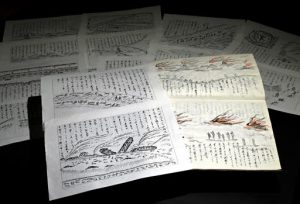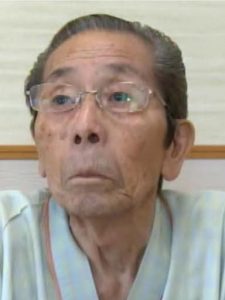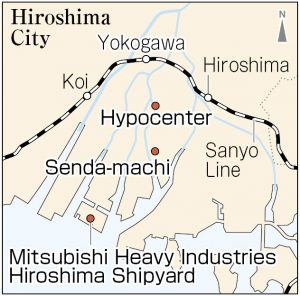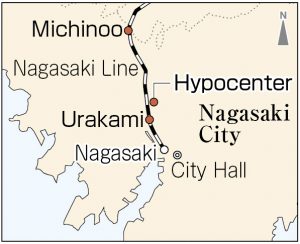Drawings by survivor of Hiroshima and Nagasaki A-bombings unique among 5,000 pieces of art stored at Hiroshima Peace Memorial Museum
Feb. 22, 2021
by Masami Nishimoto, Senior Staff Writer
One A-bomb survivor created paintings and drawings of his experiences of both atomic bombings of Hiroshima and Nagasaki. Kuniyoshi Aikawa, who died in 2017 at the age of 84, contributed 65 of his drawings to the Hiroshima Peace Memorial Museum in Hiroshima City in 2002. From his experiences in Hiroshima on August 6, 1945, to the devastation of his hometown of Nagasaki, where he traveled with his older sister on August 9, the drawings express the scenes faithfully in stark detail. They happen to be the only pieces of art by someone who described both atomic bombings among the collection of approximately 5,000 paintings and drawings at the museum created by about 1,400 survivors.
His artwork consisted of 39 drawings on manuscript paper and a sketchbook with 26 illustrations. His experiences of the Nagasaki atomic bombing were created in four drawings of that total.
Mr. Aikawa and his sister, Kinuyo Fukui, 90, Aomori City, moved to Hiroshima from Nagasaki in 1944, when his father started working at the Mitsubishi Heavy Industries Hiroshima Shipyard. Soon, their father was drafted into the military and the siblings had to live on their own in Hiroshima’s Senda-machi area.
On August 6, the two were about 1.8 kilometers from the hypocenter. He described the situation in the following way: “When I sat down at the table, there was a flash of yellow-white light.” After the blast, he pulled his sister from the collapsed house and fled to Miyuki Bridge. On the way, he saw girl students who could only groan and a dark-red baby burned to death. The two sheltered from the raging flames on Hijiyama Hill and slept in the open by the swimming pool of the Hiroshima University of Literature and Science, located in Hiroshima’s Hirano-machi area. The next day, they evacuated to Ninoshima Island off the coast of the city, accompanied by a friend of their father who came looking for them.
The siblings decided to return to their home in Nagasaki Prefecture, and headed for the Hiroshima train station in the devastated city on August 8. According to the Hiroshima Railway Bureau’s records, Hiroshima Station resumed operations of the main rail line that day, with the first south-bound train, for Hakata, train number 33, departing from Hiroshima at 3:30 p.m. The 26th drawing in the sketchbook depicts the scene on August 6 with the train, to which was added, “I never dreamed I would see the same hell in both Hiroshima and Nagasaki.”
The first of the four drawings that describe their experiences on August 9 depicts an image of a train coming from Nagasaki packed with the wounded. “I involuntarily cried out,” he wrote. The train Mr. Aikawa and his sister had taken stopped just before Michinoo Station, two stations north of the train station in Nagasaki. With that, they walked along the tracks and entered the hypocenter area. “Bodies with peeled skin were lying in heaps in the river.” One drawing’s caption explained that the two arrived in the city where their grandmother lived three hours after the atomic bombing.
Mr. Aikawa submitted 65 A-bomb drawings when the Hiroshima City government and others called for contributions of such artwork in 2002. A catalogue titled “A-bomb Drawings by Survivors,” published by the Hiroshima Peace Memorial Museum in 2007, contains a list of paintings and drawings at the end in which one of his drawings is included. However, the artist’s circumstances at the time of the bombings are not explained among the 161 drawings and paintings in the catalogue. The museum has indicated it intends to work to ensure that Mr. Aikawa’s drawings appear in search results in its Peace Database when people enter the keywords, “Person who experienced the atomic bombings in both Hiroshima and Nagasaki.”
After the war, Mr. Aikawa moved to Tokyo with his father and sister. In 1991, he wrote about his experiences in the atomic bombings of Hiroshima and Nagasaki in a work of 62 pages, which he contributed to the Tokyo Federation of A-bomb Sufferers Organizations, or Toyukai in Japanese. Mr. Aikawa spent his final years in Nagasaki, where he died.
Keywords
People who survived both the Hiroshima and Nagasaki atomic bombings
Some people experienced the atomic bombings in both Hiroshima and Nagasaki. The distance in a straight line between the cities is about 300 kilometers. Tsutomu Yamaguchi, who died in 2010 at the age of 93, was an engineer for the Mitsubishi Heavy Industries Nagasaki Shipyard at the time and officially recognized as such a survivor by the Nagasaki City government in 2009, when it entered his experiences in Hiroshima into an Atomic Bomb Survivor’s Certificate. While Japan’s Ministry of Health, Labour and Welfare has not investigated the actual number, 21 victims registered at the National Peace Memorial Hall for the Atomic Bomb Victims in both Hiroshima and Nagasaki are now described as having experienced the atomic bombings in “Both cities.”
(Originally published on February 22, 2021)
One A-bomb survivor created paintings and drawings of his experiences of both atomic bombings of Hiroshima and Nagasaki. Kuniyoshi Aikawa, who died in 2017 at the age of 84, contributed 65 of his drawings to the Hiroshima Peace Memorial Museum in Hiroshima City in 2002. From his experiences in Hiroshima on August 6, 1945, to the devastation of his hometown of Nagasaki, where he traveled with his older sister on August 9, the drawings express the scenes faithfully in stark detail. They happen to be the only pieces of art by someone who described both atomic bombings among the collection of approximately 5,000 paintings and drawings at the museum created by about 1,400 survivors.
Mr. Aikawa depicted his A-bomb experiences in Hiroshima and Nagasaki
His artwork consisted of 39 drawings on manuscript paper and a sketchbook with 26 illustrations. His experiences of the Nagasaki atomic bombing were created in four drawings of that total.
Mr. Aikawa and his sister, Kinuyo Fukui, 90, Aomori City, moved to Hiroshima from Nagasaki in 1944, when his father started working at the Mitsubishi Heavy Industries Hiroshima Shipyard. Soon, their father was drafted into the military and the siblings had to live on their own in Hiroshima’s Senda-machi area.
On August 6, the two were about 1.8 kilometers from the hypocenter. He described the situation in the following way: “When I sat down at the table, there was a flash of yellow-white light.” After the blast, he pulled his sister from the collapsed house and fled to Miyuki Bridge. On the way, he saw girl students who could only groan and a dark-red baby burned to death. The two sheltered from the raging flames on Hijiyama Hill and slept in the open by the swimming pool of the Hiroshima University of Literature and Science, located in Hiroshima’s Hirano-machi area. The next day, they evacuated to Ninoshima Island off the coast of the city, accompanied by a friend of their father who came looking for them.
The siblings decided to return to their home in Nagasaki Prefecture, and headed for the Hiroshima train station in the devastated city on August 8. According to the Hiroshima Railway Bureau’s records, Hiroshima Station resumed operations of the main rail line that day, with the first south-bound train, for Hakata, train number 33, departing from Hiroshima at 3:30 p.m. The 26th drawing in the sketchbook depicts the scene on August 6 with the train, to which was added, “I never dreamed I would see the same hell in both Hiroshima and Nagasaki.”
The first of the four drawings that describe their experiences on August 9 depicts an image of a train coming from Nagasaki packed with the wounded. “I involuntarily cried out,” he wrote. The train Mr. Aikawa and his sister had taken stopped just before Michinoo Station, two stations north of the train station in Nagasaki. With that, they walked along the tracks and entered the hypocenter area. “Bodies with peeled skin were lying in heaps in the river.” One drawing’s caption explained that the two arrived in the city where their grandmother lived three hours after the atomic bombing.
Mr. Aikawa submitted 65 A-bomb drawings when the Hiroshima City government and others called for contributions of such artwork in 2002. A catalogue titled “A-bomb Drawings by Survivors,” published by the Hiroshima Peace Memorial Museum in 2007, contains a list of paintings and drawings at the end in which one of his drawings is included. However, the artist’s circumstances at the time of the bombings are not explained among the 161 drawings and paintings in the catalogue. The museum has indicated it intends to work to ensure that Mr. Aikawa’s drawings appear in search results in its Peace Database when people enter the keywords, “Person who experienced the atomic bombings in both Hiroshima and Nagasaki.”
After the war, Mr. Aikawa moved to Tokyo with his father and sister. In 1991, he wrote about his experiences in the atomic bombings of Hiroshima and Nagasaki in a work of 62 pages, which he contributed to the Tokyo Federation of A-bomb Sufferers Organizations, or Toyukai in Japanese. Mr. Aikawa spent his final years in Nagasaki, where he died.
Keywords
People who survived both the Hiroshima and Nagasaki atomic bombings
Some people experienced the atomic bombings in both Hiroshima and Nagasaki. The distance in a straight line between the cities is about 300 kilometers. Tsutomu Yamaguchi, who died in 2010 at the age of 93, was an engineer for the Mitsubishi Heavy Industries Nagasaki Shipyard at the time and officially recognized as such a survivor by the Nagasaki City government in 2009, when it entered his experiences in Hiroshima into an Atomic Bomb Survivor’s Certificate. While Japan’s Ministry of Health, Labour and Welfare has not investigated the actual number, 21 victims registered at the National Peace Memorial Hall for the Atomic Bomb Victims in both Hiroshima and Nagasaki are now described as having experienced the atomic bombings in “Both cities.”
(Originally published on February 22, 2021)











